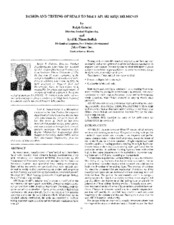| dc.description.abstract | In recent years, manufacturers of mechanical seals have been faced with meeting more stringent leakage requirements along with reliability and extended MTBPM. Regulations by Environmental Protection Agency and standards by the American Petroleum Institute, have quantified these sealing requirements. Some of the test results are described along with analysis performed to verify sealing performance on pusher and nonpusher seals in flashing and nonflashing hydrocarbons conducted per API Standard 682,” Shaft Sealing Systems for Centrifugal and Rotary Pumps,” testing requirements. API Standard 682’s mission was to create a specification for seals that would have a good probability of meeting emission regulations and have a life of at least three years. These testing requirements are set up to simulate refinery pump operation that entails continuous duty, pump shutoffs, fluid vaporization, or low pressure operation and to run the seals without a flush. While there are no pass/fail criteria established, the seals are expected to perform within regulated emission limits and demonstrate a minimum three year life. Testing seals to meet this standard required some face material evaluation and some optimization of the seal design parameters to improve performance. The testing was verified with finite element analysis to establish proper guidelines, in order to maintain design integrity with intermediate seal sizes. Two classes of mechanical seals were studied: *Process or liquid lubricated seals *Gas barrier lubricated seals. Both single and dual liquid lubricated, or contacting face seals, were tested to the standard’s requirements. In addition, tests were conducted to verify seal performance limits and to demonstrate stable operation, while being exposed to varying steady state pressures. API 682 does not currently cover the application of noncontacting gas barrier, seal designs. Testing was conducted on these seals to demonstrate their performance and reliability in real world conditions. Again testing was conducted that went beyond the standard’s requirements. In addition, field operation on some of the seals tested are demonstrated and discussed. | en |


